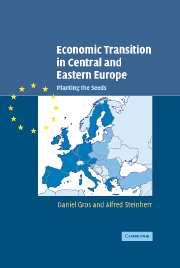Book contents
- Frontmatter
- Contents
- List of figures
- List of boxes
- List of tables
- Acknowledgements
- Introduction
- Part I The rise and decline of communism: an overview
- Part II Transition: 1990–2000
- Part III Extreme cases for reform: scope for disagreements
- 6 German unification: an example of big-bang reform
- 7 The disintegration of the Soviet Union
- 8 Russia: after a lost decade, the phoenix rises from the ashes?
- Part IV The new Europe from the Atlantic to the Urals
- References
- Index
8 - Russia: after a lost decade, the phoenix rises from the ashes?
Published online by Cambridge University Press: 05 June 2012
- Frontmatter
- Contents
- List of figures
- List of boxes
- List of tables
- Acknowledgements
- Introduction
- Part I The rise and decline of communism: an overview
- Part II Transition: 1990–2000
- Part III Extreme cases for reform: scope for disagreements
- 6 German unification: an example of big-bang reform
- 7 The disintegration of the Soviet Union
- 8 Russia: after a lost decade, the phoenix rises from the ashes?
- Part IV The new Europe from the Atlantic to the Urals
- References
- Index
Summary
Evaluating Russia is not straightforward – and has never been. In 1925, Keynes summed up his impression of the new economic system as follows:
The economic system of Russia has undergone such rapid changes that it is impossible to obtain a precise and accurate account of it … Almost everything one can say about the country is true and false at the same time.
Keynes's statement remains valid today. Judgements on the effectiveness of the reforms in Russia from international institutions, academics and the press have ranged across the entire spectrum from very optimistic to extremely pessimistic. The best example of Russo-mania remains probably Layard and Parker's (1996) title The Coming Russian Boom. This boom had a rather short life, but predictions of descent into hyperinflationary chaos and disintegration after the crisis of 1998 proved equally wide of the mark. It is thus not easy to provide an overall judgement of the reforms in Russia as already anticipated by Keynes seventy-five years earlier. Hence, this chapter does not pretend to provide a comprehensive overview of developments in Russia over the last decade. Instead it concentrates on the most salient features of the reform process in Russia, often comparing them to what happened in Central Europe (especially Russia's largest Slav brother, Poland) in order to find some general features that can help in understanding how the Russian economy works in general, and where it might be going in the future.
- Type
- Chapter
- Information
- Economic Transition in Central and Eastern EuropePlanting the Seeds, pp. 225 - 260Publisher: Cambridge University PressPrint publication year: 2004



